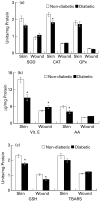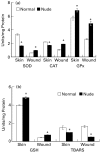Antioxidant status in delayed healing type of wounds
- PMID: 10971747
- PMCID: PMC2517731
- DOI: 10.1046/j.1365-2613.2000.00158.x
Antioxidant status in delayed healing type of wounds
Abstract
This investigation studied the contribution of antioxidants in delaying healing in excision cutaneous wounds (8 mm) in diabetic, aged and immunocompromised animals. Skin levels of catalase, glutathione (GSH), ascorbic acid (AA) and vitamin E in streptozotocin-induced diabetic rat were lower as compared to nondiabetics. The 7-d wound tissue of diabetic rats showed an increased vitamin E level along with depleted GSH content. In aged rats (18 months old), higher levels of skin superoxide dismutase (SOD), glutathione peroxidase (Gpx) and thiobarbituric acid reactive substances (TBARS) and lower levels of catalase and GSH were found as compared to their values in young rats (3-4 months old). The levels of SOD, GPx, catalase, AA, GSH and vitamin E in 7-d wound tissue of aged rats were significantly lower in comparison to those in young rats. However, TBARS were elevated in these wound tissues. The non-wounded skin of immunocompromised (athymic) mice showed lower levels of SOD, catalase, and TBARS and higher GSH and GPx levels in comparison to those present in normal mouse skin. Surprisingly, the analysis of 7-d wound tissue showed higher levels of SOD, catalase, GPx, and GSH and lower TBARS level in athymic mice compared to the wound tissue of normal mice. Thus low levels of antioxidants accompanied by raised levels of markers of free radical damage play a significant role in delaying wound healing in aged rats. In diabetic rats reduced glutathione levels may have a contributory role in delaying the healing process. However, in immunocompromised mice the antioxidant status following injury showed an adapted response.
Figures



References
-
- Aebi H. Catalase. In: BErgmeyer H U, editor. Methods of Enzymatic Analysis. Vol 2. New York and London: Academic Press; 1984. pp. 673–684.
-
- Barbul A. Immune aspects of wound repair. Clin. Plast Surg. 1990;17:433–442. - PubMed
-
- Bravenboer B, Kappelle AC, Hamers FPT, Vanburen T, Erkelens DW, Gispen WH. Potential use of glutathione for the prevention and treatment of diabetic neuropathy in the streptozotocin induced diabetic rats. Diabetologica. 1992;35:813–817. - PubMed
-
- Cohn VH, Lyle J. A fluorometric assay for glutathione. Analyt. Biochem. 1966;14:434–440. - PubMed
MeSH terms
Substances
LinkOut - more resources
Full Text Sources
Other Literature Sources
Medical

